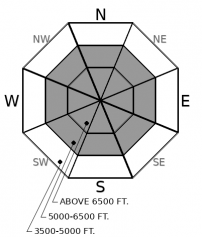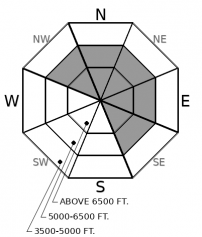| Monday | Monday Night | Tuesday | |
|---|---|---|---|
| Cloud Cover: | Mostly Cloudy | Mostly Cloudy | Mostly Cloudy |
| Temperatures: | 23 to 27 deg. F. | 19 to 24 deg. F. | 25 to 30 deg. F. |
| Wind Direction: | Southwest | Southwest | South |
| Wind Speed: | 15 to 20 gusting to 50 | 10 to 15 gusting to 30 | 10 to 15 gusting to 30 |
| Snowfall: | 2" to 5" in. | 4" to 8" in. | 3" to 10" in. |
| Snow Line: | 1000' | 3000' | 3000' |
Whitefish Range
Swan Range
Flathead Range and Glacier National Park
How to read the forecast
Today's hazards are avalanches that break 1 to 2 feet deep on old snow, or slides that involve recently-drifted snow at the snow surface. Both hazards are more widespread, with the potential to produce larger avalanches, at upper elevations. You can find safe riding that avoids these hazards on low angle, sheltered slopes at mid elevations. An approaching storm will bring sustained snowfall and yet more powerful winds tonight and tomorrow, with dangerous conditions expected by tomorrow morning.

2. Moderate
?
Above 6500 ft.
2. Moderate
?
5000-6500 ft.
1. Low
?
3500-5000 ft.
- 1. Low
- 2. Moderate
- 3. Considerable
- 4. High
- 5. Extreme
-
Type ?
-
Aspect/Elevation ?

-
Likelihood ?CertainVery LikelyLikelyPossible
 Unlikely
Unlikely -
Size ?HistoricVery LargeLargeSmall

Above about 6000 feet, you can trigger slabs that break 1 to 2 feet deep on weak snow around crusts and other weak layers buried during the Holiday week. The slabs grow thicker, stiffer, and more reactive to a person's weight as elevation increases. So tighten up your terrain choices and group management as you climb higher. Stick to slopes less than about 35 degrees that have runouts free from gullies, rockbands, and trees. You may need to dial slope angles back to 30 degrees or less as you approach summits and exposed ridges. Whumpfing collapses are an unambigious sign of danger.
-
Type ?
-
Aspect/Elevation ?

-
Likelihood ?CertainVery LikelyLikelyPossible
 Unlikely
Unlikely -
Size ?HistoricVery LargeLargeSmall

Since Saturday, riders have been reporting natural and triggered avalanches that involve slabs of recently-drifted snow. These have mostly been small and confined to spots most prone to collecting drifted snow, like the sheltered sides of ridges, gullies, rock outcrops, and other exposed terrain features. They've grown more stubborn as the amount of snow available for transport has diminished, though today's snow may fuel a few fresh and more sensitive slabs. Slides involving wind-drifted snow may be dangerous on steep slopes where they're more than about a foot thick, or above terrain traps. If they're hard and sound hollow, they can break well above you. Cornices cantilevered over a slope are a sign of fresh wind loading. Steer clear of these slopes, as well as the cornices themselves, which may break surprisingly wide or far back from ridge crests.
A system headed our way from the Pacific looks to have the ingredients to prompt rising avalanche danger over the next few days. It will produce sustained and sometimes intense snowfall accompanied by gusty winds and rising temperatures. Most of the snowfall occurs tonight into tomorrow, so the avalanche danger should hold steady today. If, however, the storm arrives early and produces more intense snow this afternoon, conditions could turn dangerous sooner than expected. Step back into more conservative terrain choices if you see more than about 8 inches of new and drifted snow today.
The ancient Greeks embodied southwesterly winds in the minor deity Lips, an unpredictable character who could be kind or destructive. Lips has apparently been hanging around, with some areas seeing moderate gusts and others recording fierce, unrelenting winds. The effects have been inconsistent, with snow surfaces in some areas still soft while many windward fetches are polished or stripped to bare ground. Cornices and dense slabs have formed on the lee sides of many mid and upper elevation ridges, and gullies at mid-elevations are cross-loaded with drifts. We've had reports of rider-triggered slabs from across the region (Flathead Pass, southern Whitefish Range, the Flathead Range, and Skyland) over the past few days. Most of these have been small, and reports have dwindled as Lips ran out of fuel Sunday.
Lips doesn't look to be leaving today, and with a few inches of snow forecast by sunset, we can expect existing wind slabs to thicken and some small fresh slabs to form. These will be most widespread, with the potential for producing larger avalanches, in upper elevation terrain above about 7000 feet. They're generally confined to exposed terrain; many mid-elevation easterly slopes have been hidden from Lips and offer good riding with less exposure to wind slab avalanche hazards.
The Greeks didn't have deities who personified weak layers, though if they did, the 12/31 rain crust would, like Lips, be an erratic and inconsistent character. Reports to date have shown this interface to be most reactive in the eastern part of the forecast region, particularly in the Lake McDonald area. That's where the crust has combined with small facets or surface hoar to create a bed surface/ persistent weak layer structure. This combination may be present elsewhere in the region, though spotty enough that it hasn't been observed consistently. It's a structure that allows for remote triggering of slides and wide propagation of triggered slides. Careful routefinding and cautious line choice can keep you from stumbling into this hazard.
Persistent weak layers buried deeper in the snowpack, like a crust buried by storms before Christmas and the 11/19 facet/ crust combination, appear to be dormant. Appear is the operative word; we've had no observations of slides releasing on the latter layer since Dec. 20. The big caveat is that observations have been limited by poor visibility and even poorer travel conditions in the areas where it's widespread. With that uncertainty, I'm still avoiding the kind of slopes where it's most likely to remain a hazard - slopes more than 35 degrees with snowpacks that vary in depth and are peppered with rocks, trees, and other spots that can promote faceted snow and trigger points.
Windy, wet, and warm. A water-laden system is headed towards the region; it will bring more gusty winds, but also sustained snowfall. And like many of our storms this season, will end warm. The snowline shouldn't climb nearly as high as recent events. Today, winds will remain moderate to strong, with powerful gusts. They should blow more from the west than past few days. Expect light snow intensifying this afternoon and evening, with the Swan Range favored.
This forecast applies only to backcountry areas outside established ski area boundaries. The forecast describes general avalanche conditions and local variations always occur. This forecast expires at midnight on the posted day unless otherwise noted. The information in this forecast is provided by the USDA Forest Service who is solely responsible for its content.































